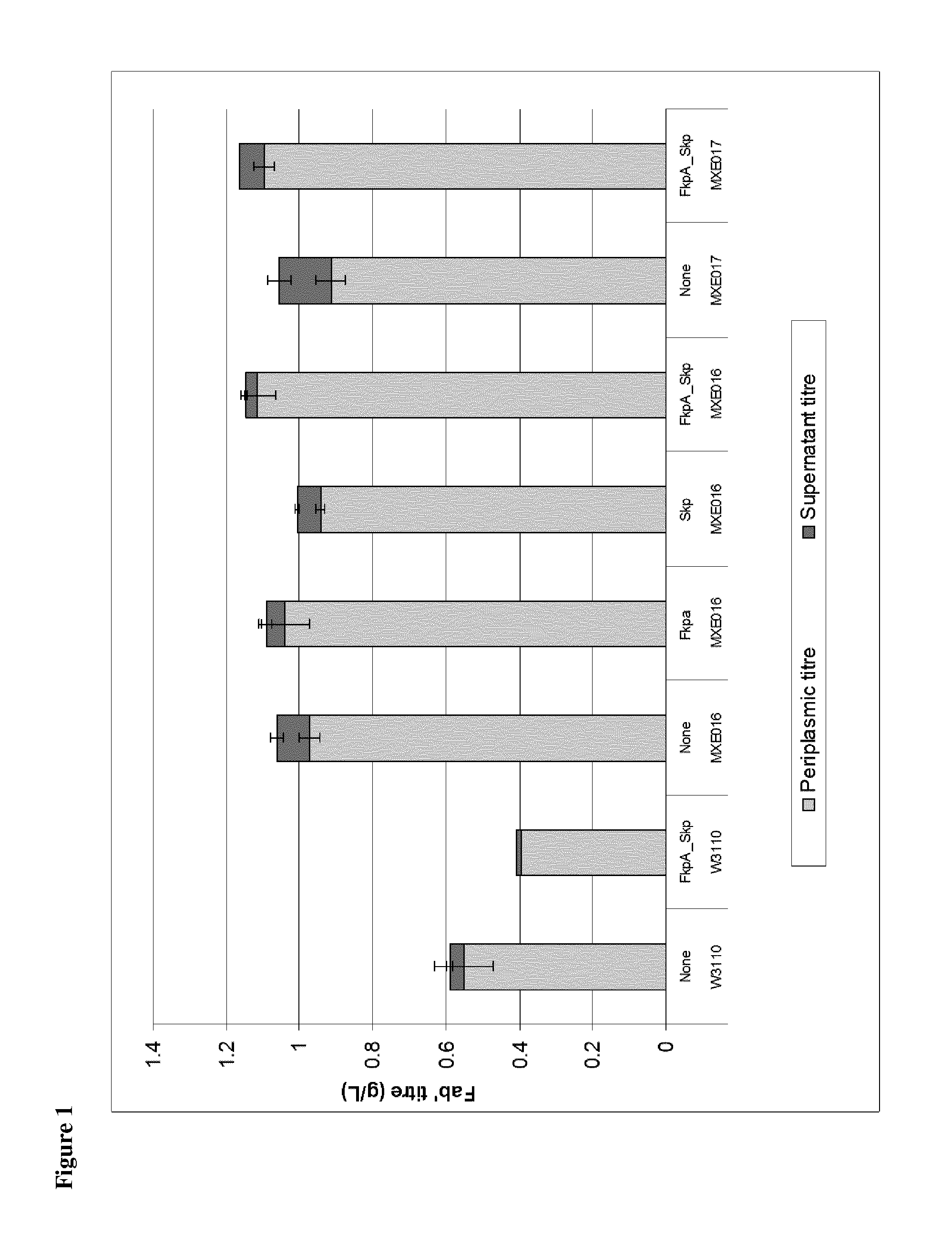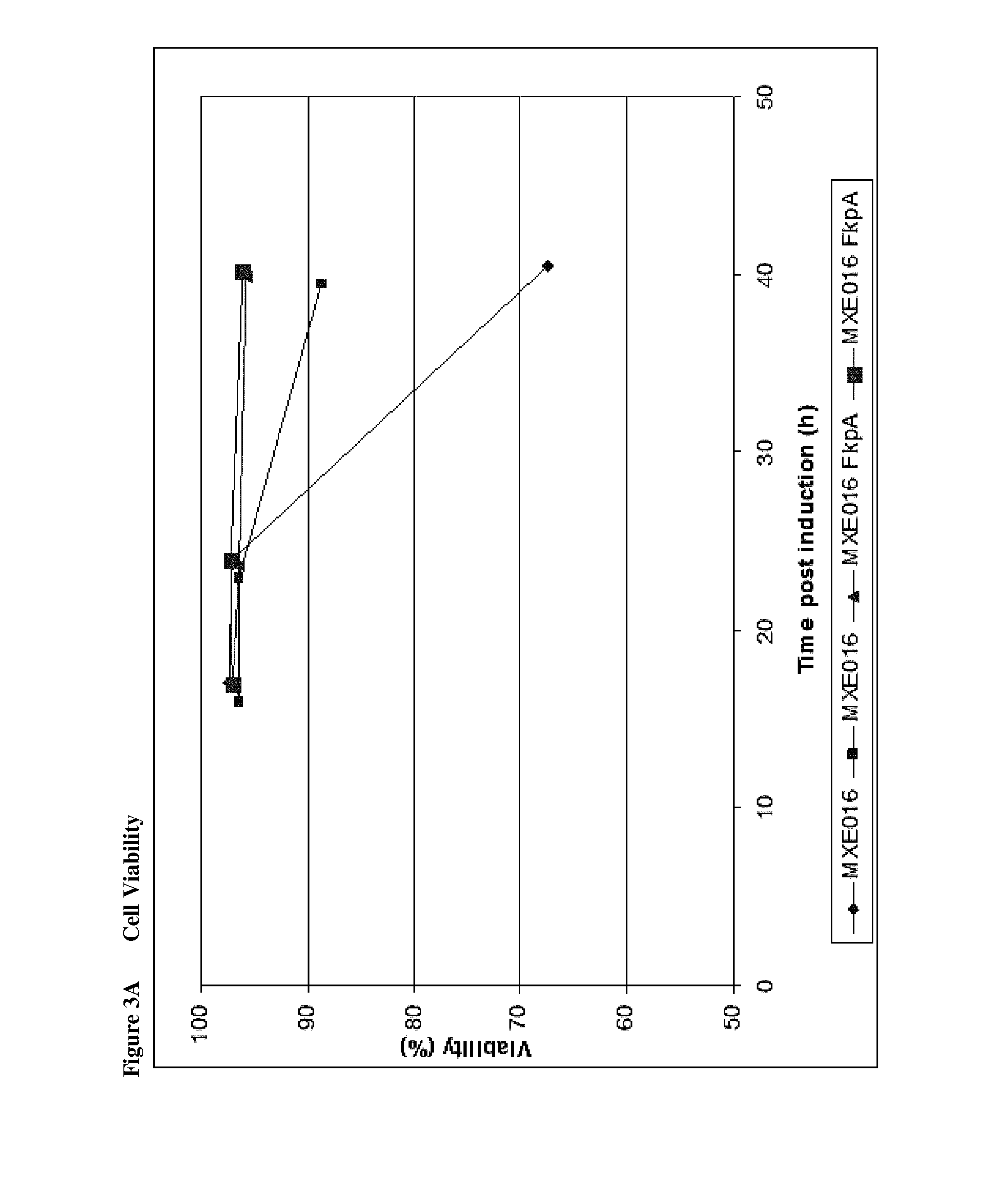Recombinant Bacterial Host Cell for Protein Expression
a bacterial host cell and protein technology, applied in the field of recombinant bacterial host cells for protein expression, can solve the problems of significant reducing the yield of active proteins, severe disadvantage of strains intended for commercial use, and difficult to produce protease sensitive proteins, etc., to achieve the effect of facilitating protein folding, and reducing tsp protein activity
- Summary
- Abstract
- Description
- Claims
- Application Information
AI Technical Summary
Benefits of technology
Problems solved by technology
Method used
Image
Examples
example 1
Generation of Cell Lines
[0290]The generation of MXE016 and MXE017 is given in WO2011 / 086136.
[0291]Generation of plasmids for anti-FcRn Fab′ expression and anti-FcRn Fab′ with FkpA, anti-FcRn Fab′ with skp and anti-FcRn Fab with both FkpA and skp expression
[0292]A plasmid was constructed containing both the heavy and light chain sequences of an anti-FcRn Fab (SEQ ID NOs: 63 and 55, respectively. Plasmid pTTOD 1519.g57 Fab′, was constructed using conventional restriction cloning methodologies which can be found in Sambrook et al 1989, Molecular cloning: a laboratory manual. CSHL press, N.Y. The plasmid pTTOD 1519.g57 Fab′ contained the following features; a strong tac promoter and lac operator sequence. The plasmid contained a unique EcoRI restriction site after the coding region of the Fab′ heavy chain, followed by a non-coding sequence containing a strong ribosome binding site and then a unique NdeI restriction site.
[0293]The Fab light chain, heavy chain genes were transcribed as a ...
example 2
Effect of Chaperones on Fab′ Expression
[0298]The strains shown in FIG. 1 were tested in 1 L and 2.5 L fermentation experiments comparing expression of Fab′:
Growth Medium, Inoculum and Fermentation Steps.
[0299]The fermentation process was initiated by preparing an inoculum from a vial of the cell bank and amplifying through several pre-culture stages (flask and reactors) before seeding of the production fermenter. In the production fermenter, the cells were grown in defined media to high density in batch and fed-batch mode. When the desired cell density was reached expression of the Fab′ was induced by the addition of IPTG. The Fab′ expression is targeted to the E. coli periplasmic space, where Fab′ accumulates throughout the course of the induction phase. A carbon source feed was applied during the induction phase to control expression and cell growth. Temperature, dissolved oxygen (pO2) and pH were controlled to maintain the culture within optimal culture conditions.
Measurement of ...
example 3
Effect of Post Induction Feed Rate
[0305]The effect of three different post induction feed rates 5.4, 6.0 and 7.0 g / h was tested on MXE016 and MXE016+FkpA.
[0306]Growth Medium, Inoculum and Fermentation Steps.
[0307]The fermentation process was initiated by preparing an inoculum from a vial of the cell bank and amplifying through several pre-culture stages (flask and reactors) before seeding of the production fermenter. In the production fermenter, the cells were grown in defined media to high density in batch and fed-batch mode. When the desired cell density was reached expression of the Fab′ was induced by the addition of IPTG. The Fab′ expression is targeted to the E. coli periplasmic space, where Fab′ accumulates throughout the course of the induction phase. A carbon source feed was applied during the induction phase to control expression and cell growth, in this experiment the feed rate set at three separate setpoints (shown in the figure). Temperature, dissolved oxygen (pO2) and ...
PUM
| Property | Measurement | Unit |
|---|---|---|
| temperature | aaaaa | aaaaa |
| temperatures | aaaaa | aaaaa |
| temperatures | aaaaa | aaaaa |
Abstract
Description
Claims
Application Information
 Login to View More
Login to View More - R&D
- Intellectual Property
- Life Sciences
- Materials
- Tech Scout
- Unparalleled Data Quality
- Higher Quality Content
- 60% Fewer Hallucinations
Browse by: Latest US Patents, China's latest patents, Technical Efficacy Thesaurus, Application Domain, Technology Topic, Popular Technical Reports.
© 2025 PatSnap. All rights reserved.Legal|Privacy policy|Modern Slavery Act Transparency Statement|Sitemap|About US| Contact US: help@patsnap.com



